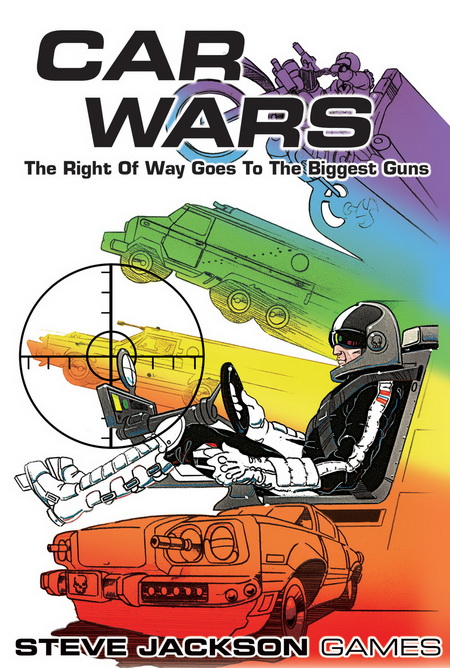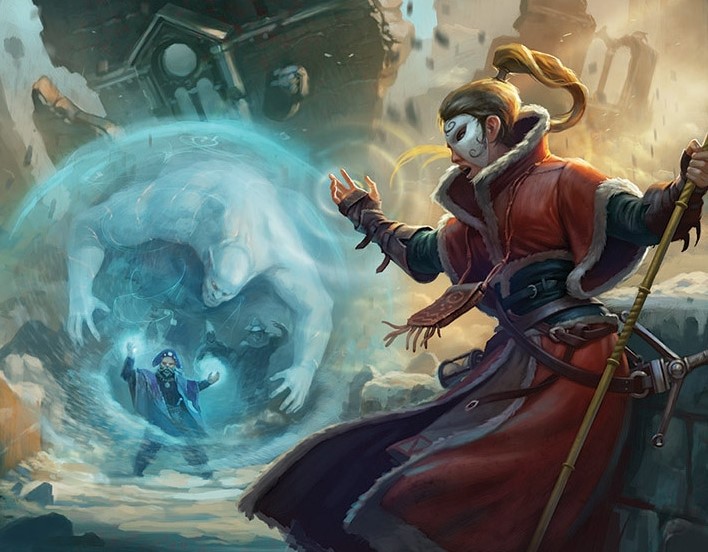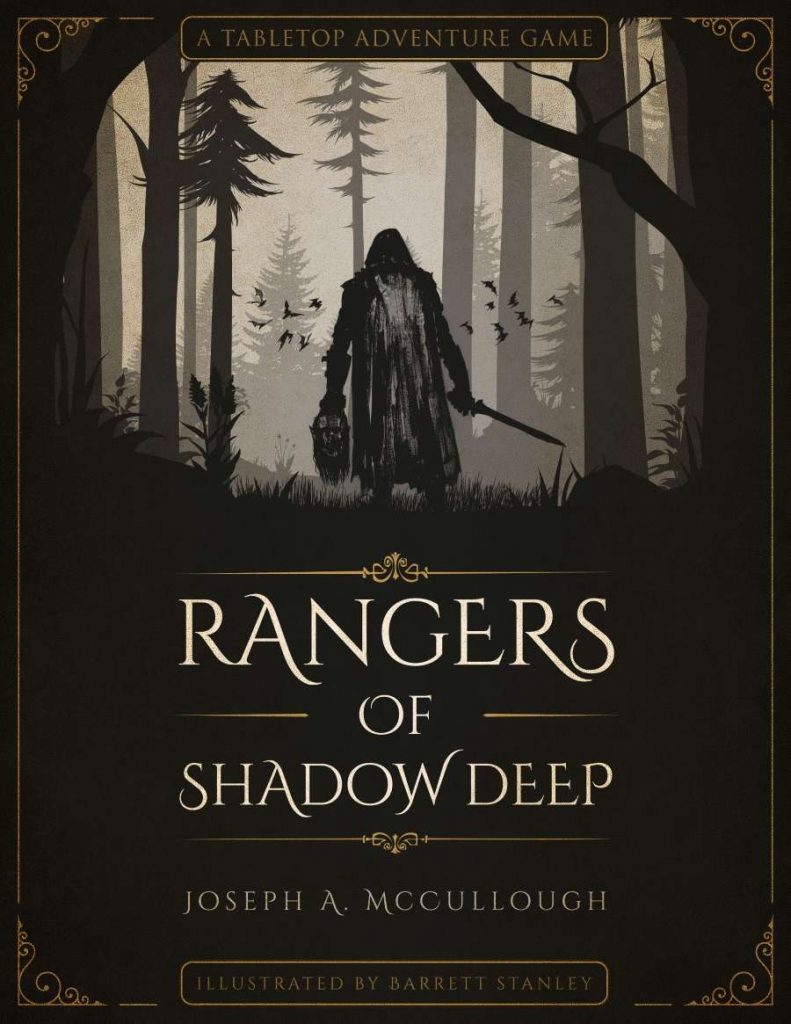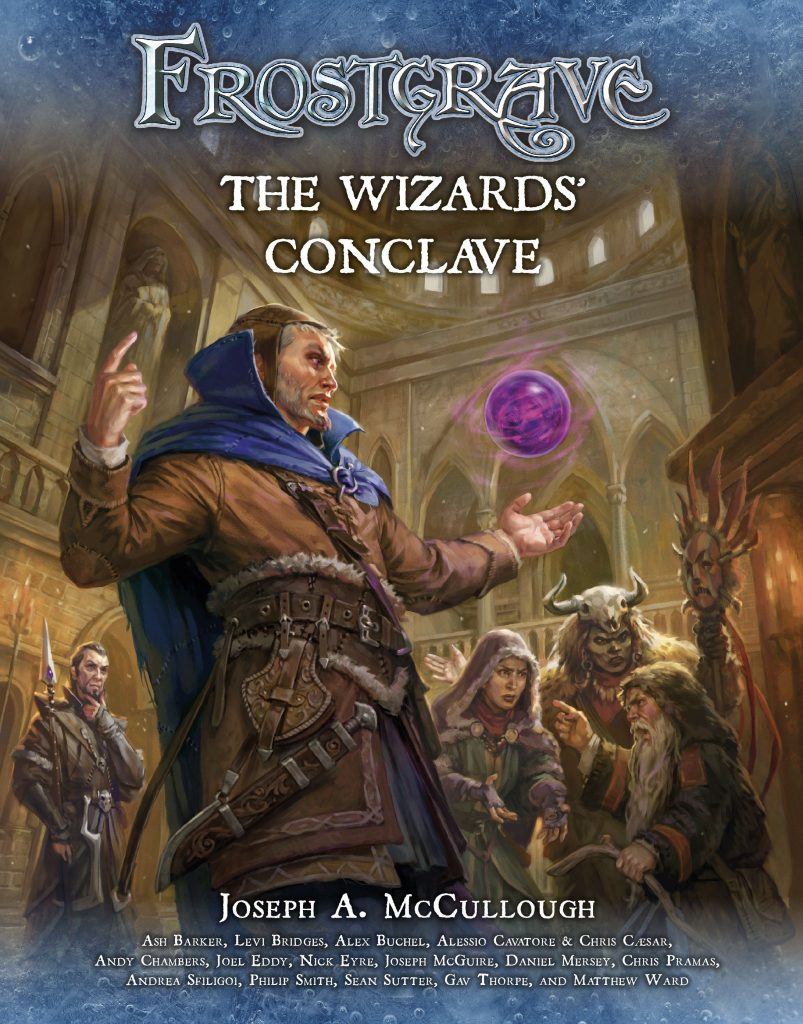Behind The Board Games: Frostgrave Creator Joseph McCullough
February 14, 2019 by brennon
I've currently been getting into the hobby side of Rangers Of Shadow Deep, a new solo and co-operative wargame from Joseph McCullough. So, when I got a chance to chat with the man and find out more about his past and his methods I jumped at it!
Delve in below! You can find his own personal musings on the blog, The Renaissance Troll.
Ben: How did you first get into tabletop games?
Joseph: When I was very young, I would play with toy soldiers, invent scenarios, and use dice to determine who lived and died, so I guess I was playing them before I ever came across an actual set of rules. In my early teens, I got into role-playing games, D&D and Call of Cthulhu, especially. At some point, I started painting minis for these games and slowly learned about ‘wargaming’ as a separate category.
By the time I went to university, Games Workshop was first starting to make in-roads into the US, so I played some of their games, but also a lot of others games like Car Wars and Battletech.
When I moved to the UK about twelve years ago, I discovered just how big wargaming was in the U.K., and slowly I transition from being more of role-player to more of a tabletop wargamer.
B: When did you first know you wanted to be a tabletop game designer?
J: That’s never really been a goal. For a long time, I wanted to be a writer. I wrote a lot of fiction in my twenties and originally came to the U.K. to pursue an MFA in creative writing. Instead, I got married, stayed in the U.K. and got a job with the famous military history publisher, Osprey Publishing.
Over the years I wrote several books for them, such as Zombies: A Hunter’s Guide, Dragonslayers: From Beowulf to St. George, and Steampunk Soldiers: Uniforms & Weapons from the Age of Steam.
Then one day the Head of Osprey Games challenged me to write a wargame. Before that, I had dabbled with some rules here and there but never gave any serious thought to doing it professionally. I wrote the game, it was called Frostgrave, and suddenly I was a game designer.
B: Who was your inspiration within the industry when you were starting out?
J: For the most part, I have been inspired by specific games, not necessarily creators. That said, if I had to point to one person, I would probably say Steve Jackson. I mean look at the diversity of his creations: Car Wars, GURPs, Illuminati, Munchkin, Ogre.
He’s not so widely known in the U.K., but he’s one of the giants in the USA. The guy has created some seriously good games and ones that have very little in common.
B: Do you have anyone who inspires you now?
J: Most of my inspiration comes from outside of the industry. I read a lot of both fiction and non-fiction, and tend to draw my inspiration from there. I think diverse reading is an important part of any creative lifestyle, as you just never know where inspiration will come from.
Most likely little pieces will come from all over the place and you can hopefully bring them together into something new.
B: Tell us a bit about your design process. Where do you start when it comes to designing games?
J: I try to start by identifying the key mechanic in a game. In a wargame that is likely to be the combat mechanic, but it doesn’t have to be (for example, I would say that Movement is the key mechanic in X-Wing). Once you know what that is, it is important to develop that mechanic so that it accomplishes what you want it to do and it has the right feel for the game you are designing.
For example, in the mass battle game Oathmark that I’m developing for Osprey, a decision that most combats would be resolved by rolling 5d10. I thought this would give some of the feel of the ‘old bucket of dice’, but with more speed and variation. I then puzzled out how to make this work for what I needed.
Once you have your key mechanic developed, you can use that to guide you through all of the other mechanics (so knowing that the game used d10s already, I tried to design the game to use d10 exclusively). Of course, it is really a very messy process and often pieces have to be taken apart, tinkered with and possibly discarded.
B: What have been some of the stumbling blocks you’ve encountered when working in the industry?
J: The hardest part for me is handling criticism. Although I’ve been very lucky that my games have gotten a lot of praise, there are plenty of people who don’t like them, or don’t like specific elements of them and like to make their feelings known. While such criticism can be useful, I encourage everyone to remember when offering criticism, to any game, there is someone, maybe a lot of people, who put a lot of effort into that work.
Just be respectful and think about how you would like people to comment upon your own creative efforts. It can be hard to take, and since designers, like all creatives, pretty much have to provide their own motivation for their work, a little knock can prove to be a big set-back.
I’ve gotten better at handling it over the years and having a few successes really helps with the self-confidence, but you really need to be careful when and where you go online to make sure it doesn’t damage the work you need to do that day.
B: Frostgrave and now Rangers of Shadow Deep have really grabbed the attention of tabletop gamers. Why do you think this is?
J: Both games were designed to allow players a huge degree of creative freedom. Not only can they use whatever miniatures they want, but they can then create characters to match those miniatures (or vice versa).
For a lot of gamers out there, wargames are a vehicle for storytelling, but most of the big games on the market don’t really cater to that. I like to write ‘narrative-based’ wargames, and I think there are a lot of gamers that prefer that idea to be at the heart of their games.
That said, I’ve also just been very lucky. First, I was lucky in some of the amazing people that have helped me out along the way. For Frostgrave, I had the backing of Osprey and my editor Phil. The artists Dmitry and Kate Burmak are just so good.
Nick and his team at North Star have worked with Osprey to bring out some amazing miniatures. All of those things cause people to sit up and take notice. Also, I’ve gotten some big boost from the games media, such as yourselves, with Frostgrave winning your Best Miniature Game in 2015.
B: Do you have a favourite aspect or expansion for Frostgrave which has really stuck with you?
J: Ulterior Motives, no question. I’m really proud of Frostgrave: Ulterior Motives because I think it does something that has never really been done in wargaming before. For those that don’t know it, Ulterior Motives is a deck of oversized cards. Each player draws one before the game and it gives them a kind of side-quest to try and accomplish during the game.
Most of these are kept a secret and involve interacting with terrain on the table. It just really pushes the game further with regards to storytelling. It hasn’t been one of the better selling expansions, but it remains my favourite.
B: Rangers Of Shadow Deep is different from many typical skirmish games in that it explores solo and co-operative adventures. What was it that had you looking to explore this?
J: I wanted to see how close I could bring the classic fantasy role-playing experience to a tabletop wargame without using a game master. I had seen some board games that did a pretty good job with this, but board games are much more limited than wargames. I wanted to see if I could combine the creative freedom of the wargame with the mystery and adventure of an RPG.
Not only did this kind of hark back to that little kid playing alone with toy soldiers (sounds lonely but I was having fun!), but it was also a really interesting challenge from a mechanics standpoint. It took about a year to create Rangers of Shadow Deep, but I’m pretty proud of the result.
B: What can we expect to see from you in the coming year?
J: I’ve got a pretty full slate. There is already one expansion for Rangers Of Shadow Deep in design, with another partially written. The Wizard’s Conclave comes out later this month for Frostgrave, with another supplement later in the year.
There is a supplement for Ghost Archipelago coming in a few months, and, of course, near the end of the year, Osprey is due to release my mass-battle fantasy game Oathmark. There will probably be some other bits and pieces, but that’s the bulk of it. Of course, most of that stuff is already written and done; for me, I’m at work on what’s happening in 2020!
B: What do you think we can expect from the industry in the coming year?
J: More, more, more! I think that’s been the real story of the industry in the last couple of years. The sheer volume of ‘stuff’ coming out. The resurgence of Games Workshop. The rise of Fantasy Flight. The unending Kickstarters and loads of new little companies trying to break in. It’s probably unsustainable, as we all only have so much hobby time.
I think we will see more games trying out co-operative methods of play. Further on, I think we will see digital play an ever-increasing roll in the hobby – a lot of the mechanics I use in Rangers could be taken to the next level through apps. 3D printing is going to play an ever-increasing part, as the printers become small, faster, cheaper, simpler.
B: What would be your advice to others aspiring to break into the industry?
J: Lock yourself in a room. Turn off your phone and your internet. Write and Design. Don’t emerge until you have a full ruleset ready for people to try out. Seriously, the world is so full of distractions. The biggest single step that separates a game designer from someone who wants to be is the physical act of sitting down, designing a system, and writing it all down.
There are other difficult steps after that, but unless you’ve done that one, none of the rest of it really matters.
Give yourself the time and the headspace to be creative.
B: Do you have a favourite event that you like to attend?
J: If I could only go to one show every year, it would be AdeptiCon, just outside of Chicago. This is a wonderful event, run completely by volunteers. It’s big, but not overwhelming. Most importantly, it is completely about miniature wargaming.
It doesn’t have to share time with anything else. It’s three days long so it has a very relaxed pace. The dealers are smack in the centre of the gaming area. There are loads of panels, hobby workshops, pick-up games. It’s really just wonderful.
B: What are you currently playing?
J: Although I buy and read a huge number of games, I only rarely play anything. There just isn’t a lot of time left over after doing all of the playtesting for my own games.
That said, some of my favourite games that I will play any chance I get include Dragon Rampant, Space Hulk (1st Edition), Starship Troopers, Ambush Alley, Middle-Earth Battle Companies, Silent Death and Battletech.
Thanks to Joseph for talking with us and hopefully you get your hands on Frostgrave, Rangers Of Shadow Deep and the upcoming Oathmark so you can give them a go!
Have you been diving deep into these games?
"It can be hard to take, and since designers, like all creatives, pretty much have to provide their own motivation for their work, a little knock can prove to be a big set-back..."
Supported by (Turn Off)
Supported by (Turn Off)
"This is a wonderful event, run completely by volunteers. It’s big, but not overwhelming. Most importantly, it is completely about miniature wargaming..."
Supported by (Turn Off)





























![TerrainFest 2024 Begins! Build Terrain With OnTableTop & Win A £300 Prize! [Extended!]](https://images.beastsofwar.com/2024/10/TerrainFEST-2024-Social-Media-Post-Square-225-127.jpg)






















































Another good one guys frostgrave does look a good game. a bucket of dice a closet Ork player?
Some of the best gaming nights I’ve had, have been playing Frostgrave. It certainly does produce a disproportionate amount of legendary moments which get recounted when ever the occasion allows. The rules allow for a lot of freedom so you can add your own bent on the game too.
Great interview. Met the man at Salute a few years ago. He was taking questions, helping on the stall and sold me a sprue of the Oathmark dwarves. I was a bit star struck-ish, but I think I managed to compliment him without it being too odd. I said I especially liked Frostgrave Dark Alchemy because of the solo play element. He said he was looking in that direction, but chronologically I think he was working on Ghost Archipelago by that point. Joseph has been kind enough to comment on some of my RoSD posts on Facebook and just as… Read more »
I have enjoyed Frostgrave since it debuted. It was the first game that my wife asked me if she could build her own unit. We’ve sat at the table building a lot of brick by brick terrain for Frostgrave.
It’s great to ‘hear from the author’. Thanks @brennon
I also bought the softcover ‘Rangers of Shadow Deep’ when BoW first told us about it. It’s been great, I love the solo play aspect.
Any chance of finally getting a ‘Lets Play’ of Frostgrave?
That creative freedom is something I’ve loved in Frostgrave, especially on the hobby side. I’ve painted most of the monsters table and a few scenario pieces with more on the way (I’ve static grass to put on my latest batch this morning). Rangers of Shadow Deep will continue that for me.
Thanks Joseph – you’re writing some of my favorite games right now.
Great interview, nice to understand the background and process behind these creations.
I’m late to the party and picked up Frostgrave only recently because of all the good press.
I found the rules to be elegant and most importantly they don’t intrude too much on the fantastic storytelling opportunities that the well written setting and scenarios provide. The fact I can use whatever minis I like the look of is just the icing on the cake for me.
I didn’t know about Rangers of Shadow Deep bit rest assured I’ll be picking up a copy ASAP.
In case you might be unaware, NorthStar do a metal conversion kit for the Frostgrave plastics….
http://www.northstarfigures.com/prod.php?prod=8279
Perfect for making up those Rangers 🙂
Great interview! I have really appreciated how involved Joseph has been with the players on Facebook and Twitter. Absolutely loving Frostgrave 🙂